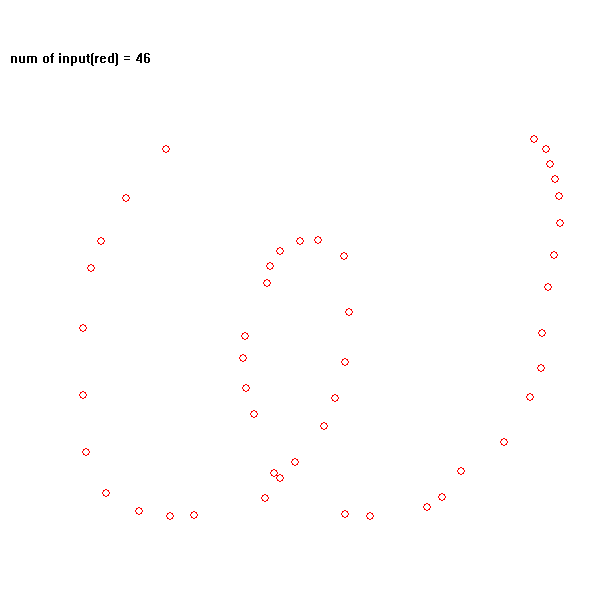타원 외부의 한 지점에서 타원까지의 최단거리를 구하자. 타원 피팅 문제에서 피팅 에러를 예측하는데 유용하게 사용할 수 있다. 일반적인 타원은 타원의 중심과 회전각을 구해서 원점으로 평행이동 후 다시 반대로 회전시켜서 표준형으로 만든 후 구하면 되기 때문에 표준형에 대해서만 고려해도 충분하다.(외부점도 동일하게 평행이동 시키고 회전시켜야 한다). 또한 표준형 타원의 경우도 대칭성에 의해서 외부점이 1 사분면에 있는 경우만 살펴보면 충분하다.
외부점
우선 타원 상의 한 점
이고,
접점
로 매개화하면 최단거리를 주는 점을 찾는 문제는 다음

/*(a, b)=radii of ellipse; 타원에 포함되는 점에 대해서는 초기조건 설정에 주의;*/
double dist2Ellipse(double p, double q, double a, double b, double& xt, double& yt) {
if (a == b) return dist2Circle(p, q, a, xt, yt); //원의 경우 별도 처리;
if (x == 0 && y == 0) //원점의 경우 별도처리;
if (a > b) { xt = 0, yt = b; return b;}
else { xt = a, yt = 0; return a;}
double x = fabs(p), y = fabs(q);
const double eps = 0.01 / max(a, b);
const int maxiters = 10;
double t;
if ((x*x/a/a + y*y/b/b) < 1) {// 타원 내부의 경우 초기조건의 조정이 필요함;
double t1 = atan2(y/b, x/a), t2 = atan(1.);
if (a > b) t = max(t1, t2);
else t = min(t1, t2);
} else t = atan2(y/b, x/a);
for (int iter = 0; iter < maxiters; iter++) {
double c = cos(t), s = sin(t);
double f = (a*a - b*b)*c*s - a*x*s + b*y*c;
if (f == 0) break;
double Df = (a*a - b*b)*(c*c - s*s) - a*x*c - b*y*s;
double dt = -f/Df;
t += dt;
t = max(0, min(2*atan(1.), t)); //[0:pi/2];
if (abs(dt) < eps ) break;
}
xt = a * cos(t); yt = b * sin(t);
xt = p >= 0? xt: -xt;
yt = q >= 0? yt: -yt;
return hypot(p-xt, q-yt);
}위 알고리즘은 Newton-Raphson iteration이 수렴하지 않을 수도 있다. 좀 더 좋은 방법은 외부점에서 타원에 내린 수선의 발에서 접촉원(osculating circle)을 구하면 수선의 연장선은 접촉원의 중심을 지난다.
만약 타원의 한 지점에서 접촉원 중심과 외부점을 연결하는 직선이 접선에 수직이 아닌 경우에는 그 지점은 최단점이 아니다. 이때는 이 직선과 타원의 교점까지의 거리가 좀 더 짧아진다. 다시 이 교점에서 접촉원을 구한 후 외부점과 중심을 연결하는 선분이 교차하는 새로운 교점을 찾는 과정을 반복하면 점점 교점은 최단점에 접근함을 알 수 있다. 이를 이용하면 좀 더 효율적인 점과 타원사이의 최단거리를 구하는 알고리즘을 만들 수 있다. 타원 위의 한 점
이다. 물론 이 지점이 정확히 타원 위에 있지는 않다. 타원 위에 있는 점은 각 축의 반지름으로 각성분을 나누면 단위원 위에 있어야 한다는 사실을 이용하면
인
로 된다.

double dist2Ellipse2(double p, double q, double a, double b, double& xt, double& yt) {
if (a==b) return dist2Circle(p, q, a, xt, yt);//원의 경우에는 별도로;
const double px = abs(p), double py = abs(q);
const double eps = 0.01/max(a,b);
const double cc = a*a - b*b;
double cost, sint;
//근이 여러개 존재하므로 초기값 설정에 주의해야 한다;
if ((px*px/a/a + py*py/b/b) < 1) //타원에 포함되는 경우;
cost = sint = 1/sqrt(2.); // pi/4에서 출발;
else { //타원바깥에 있는 경우;
cost = cos(atan2(py/b, px/a));
sint = sin(atan2(py/b, px/a));
}
double t = 1, told = t;
while (1) {
// 곡률중심;evoute
double cx = cc * pow(cost, 3.) / a;
double cy = - cc * pow(sint, 3.) / b;
// 곡률중심에 대한 타원 위의 점(교점)
double x = a*cost - cx, y = b*sint - cy;
// 곡률중심에 대한 외부점 변위
double qx = px - cx, qy = py - cy;
//거리;
double r = hypot(x, y), q = hypot(qx, qy);
cost = min(1, max(0, (qx * r / q + cx) / a));
sint = min(1, max(0, (qy * r / q + cy) / b));
double t = hypot(cost, sint); //1이 되면 좋지만 안되는 경우;
cost /= t; sint /= t;
if (abs(t-told) < eps) break;
told = t;
}
xt = abs(a *cost), yt = abs(b *sint);
xt = p >= 0 ? xt: -xt;
yt = q >= 0 ? yt: -yt;
return hypot(p - xt, q - yt);
}

'Computational Geometry' 카테고리의 다른 글
| Natural Cubic Spline (0) | 2024.03.11 |
|---|---|
| Approximate Distance Between Ellipse and Point (0) | 2024.03.08 |
| Data Fitting with B-Spline Curves (0) | 2021.04.30 |
| Closest Pair of Points (0) | 2021.04.27 |
| DDA Algorithm (0) | 2021.04.25 |





